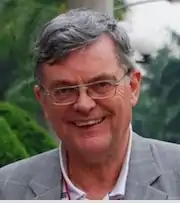Thomas Maurice Rice
Thomas Maurice Rice (born 26 January 1939 in Dundalk, Ireland; known professionally as Maurice Rice) is an Irish (and naturalised American) theoretical physicist specializing in condensed matter physics.
T. Maurice Rice | |
|---|---|
 | |
| Born | 26 January 1939 |
| Alma mater |
|
| Awards |
|
| Scientific career | |
| Fields | Theoretical Condensed Matter Physics |
| Institutions |
|
Life
Rice is the younger brother of structural engineer Peter Rice. He grew up in 52 Castle Road, Dundalk in County Louth with his two siblings. Like his brother, he studied at the local Christian Brothers school. Subsequently he studied physics as an undergraduate at University College Dublin and as a graduate student with Volker Heine at the University of Cambridge. In 1964, he moved to the US and spent two years as a post-doc with Walter Kohn at the University of California, San Diego. Then he joined the technical staff at Bell Labs in 1966, where he stayed until 1981, when he joined the Institute for Theoretical Physics at the Eidgenössische Technische Hochschule (ETH) in Zurich, Switzerland.
Rice and his wife, Helen, moved with their family of a son and two daughters from New Jersey to Zurich. Rice retired from teaching in 2004 and is an Emeritus Professor at ETH.[1][2]
Career
Rice graduated at a time when the field of condensed matter physics expanded from the study of just simple metals and semiconductors to cover a broad range of compound materials. This led him to collaborate with both theorist and experimentalist colleagues to interpret novel electronic properties of these materials. Bell Labs in the 1960s and 1970s provided the ideal environment for such collaborations. Rice's contributions covered a range of topics and materials, including metal-insulators transitions in transition metal oxides, electron-hole liquids in optically pumped semiconductors and charge and spin density waves.
In the early 1980s, Rice moved to ETH, a few years before Georg Bednorz and K. Alex Müller at the nearby IBM laboratories, made their discovery of high temperature superconductivity in layered cuprate compounds. Rice quickly switched his research to the challenges and puzzles posed by these novel and exceptional superconductors. Cuprates rapidly became a major topic in condensed matter physics, as a large range of spectacular properties in addition to high temperature superconductivity were discovered. Rice and his collaborators concentrated on developing a consistent microscopic interpretation of the various novel experimental results. The biggest challenge is the microscopic description of the mysterious pseudogap phase, which appears in a range of intermediate hole doping. Together with a series of talented graduate students and postdocs, he has focused on the role of enhanced Umklapp scattering in a nearly half-filled band as the key to the unexpected features. The physics of cuprates, even after three decades of research, remains very active with many open and controversial questions.
Awards and honours
- D.Sc (h.c.) National University of Ireland (1989)[3]
- Honorary Member, Royal Irish Academy (1988)[4]
- Member, National Academy of Sciences (1993)[5]
- Fellow of The Royal Society (2002)[6]
- EPS Europhysics Prize (1998)
- John Bardeen Prize for Superconductivity Theory (2000)[7]
Selected papers
The following papers are Rice's most cited:
- Brinkman, W. F.; Rice, T. M. (15 November 1970). "Application of Gutzwiller's Variational Method to the Metal-Insulator Transition". Physical Review B. 2 (10): 4302–4304. Bibcode:1970PhRvB...2.4302B. doi:10.1103/PhysRevB.2.4302.
- Brinkman, W. F.; Rice, T. M. (15 February 1973). "Electron-Hole Liquids in Semiconductors". Physical Review B. 7 (4): 1508–1523. Bibcode:1973PhRvB...7.1508B. doi:10.1103/PhysRevB.7.1508.
- Zhang, F. C.; Rice, T. M. (1 March 1988). "Effective Hamiltonian for the superconducting Cu oxides". Physical Review B. 37 (7): 3759–3761. Bibcode:1988PhRvB..37.3759Z. doi:10.1103/PhysRevB.37.3759. PMID 9944993.
- Honerkamp, C.; Salmhofer, M.; Furukawa, N.; Rice, T. M. (2 January 2001). "Breakdown of the Landau-Fermi liquid in two dimensions due to umklapp scattering". Physical Review B. 63 (3): 035109. arXiv:cond-mat/9912358. Bibcode:2001PhRvB..63c5109H. doi:10.1103/PhysRevB.63.035109.
- Rice, T M; Yang, Kai-Yu; Zhang, F C (1 January 2012). "A phenomenological theory of the anomalous pseudogap phase in underdoped cuprates". Reports on Progress in Physics. 75 (1): 016502. arXiv:1109.0632. Bibcode:2012RPPh...75a6502R. doi:10.1088/0034-4885/75/1/016502. PMID 22790307. S2CID 15563340.
